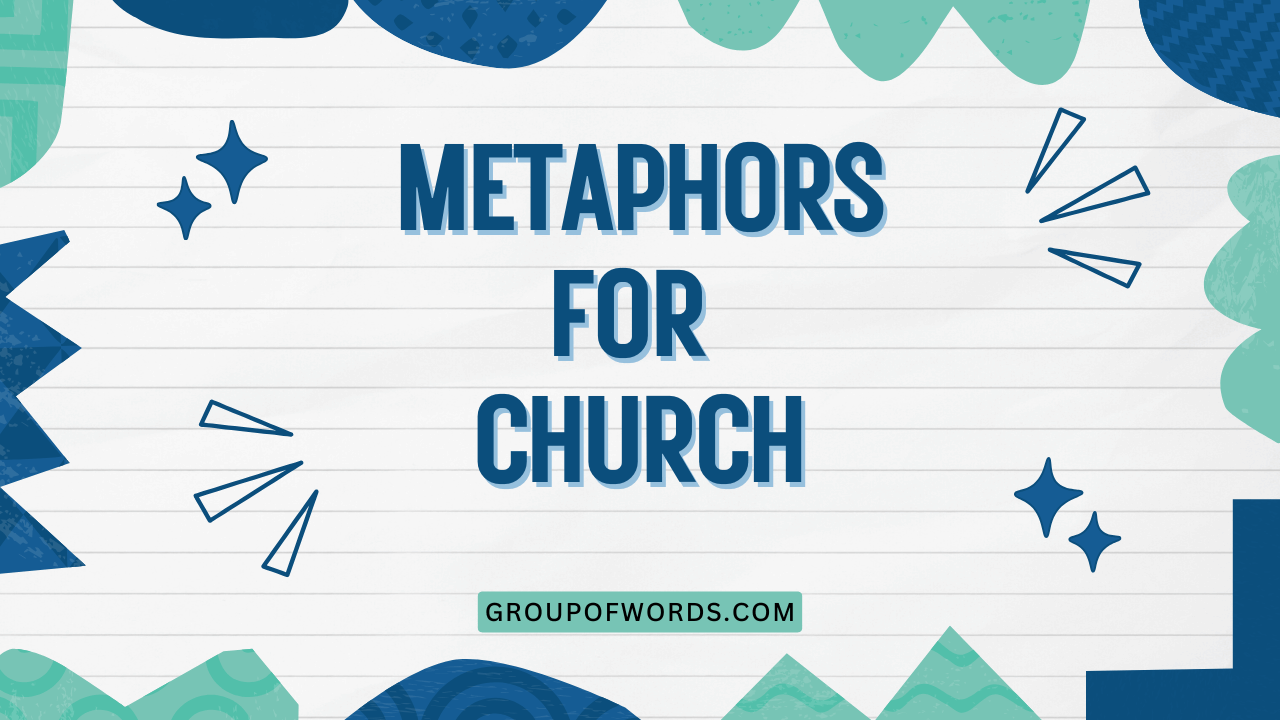Metaphors for Church: Exploring Symbolic Language
Understanding metaphors is crucial for interpreting language, especially when discussing abstract concepts like the church. Metaphors provide a tangible way to grasp the multifaceted nature of this institution.
This article delves into the various metaphors used to describe the church, examining their grammatical structures, usage, and significance. This comprehensive guide will benefit English language learners, theology students, and anyone interested in understanding the symbolic language used to describe the church.
By exploring these metaphors, we gain a deeper appreciation for the richness and complexity of the church’s role in society and individual lives.
Table of Contents
- Introduction
- Definition of Metaphor and Church
- Structural Breakdown of Metaphors
- Types of Metaphors for Church
- Examples of Metaphors for Church
- Usage Rules for Metaphors
- Common Mistakes When Using Metaphors
- Practice Exercises
- Advanced Topics in Metaphorical Language
- Frequently Asked Questions
- Conclusion
Definition of Metaphor and Church
A metaphor is a figure of speech that directly compares two unrelated things without using “like” or “as.” It asserts that one thing *is* another, not just that it resembles it. Metaphors are powerful tools for conveying complex ideas, evoking emotions, and creating vivid imagery. They enhance our understanding by drawing parallels between familiar concepts and new or abstract ones. Understanding metaphors is critical to comprehending nuanced meanings within literature, poetry, and everyday conversation.
The term church, in this context, refers to the Christian community of believers, both locally and universally. It’s not merely a physical building but encompasses the people who share a common faith and purpose. The church serves as a place of worship, fellowship, learning, and service. It’s a dynamic organism characterized by its members’ relationships with God and each other. Metaphors help us understand the multifaceted roles and functions of the church beyond its literal definition.
Structural Breakdown of Metaphors
Metaphors typically consist of two main components: the tenor and the vehicle. The tenor is the subject to which metaphorical attributes are ascribed (in our case, the church). The vehicle is the object or concept whose attributes are borrowed to describe the tenor. The connection between the tenor and vehicle creates a new understanding of the tenor. For example, in the metaphor “The church is a lighthouse,” the church is the tenor, and the lighthouse is the vehicle. The qualities of a lighthouse (guidance, safety, visibility) are attributed to the church.
Understanding the relationship between the tenor and the vehicle is crucial for interpreting the meaning of the metaphor. The effectiveness of a metaphor depends on the clarity and relevance of this relationship.
A well-chosen vehicle can illuminate aspects of the tenor that might otherwise remain obscure. The choice of vehicle also influences the emotional and intellectual response to the metaphor.
Types of Metaphors for Church
The richness of the concept of “church” lends itself to a wide array of metaphorical representations. Each metaphor highlights different aspects of the church’s nature, purpose, and function.
We will explore some of the most common and significant metaphors used to describe the church.
The Church as the Body of Christ
This metaphor, derived from the writings of Paul the Apostle, emphasizes the unity and interdependence of believers. Just as a body has many parts that work together, so too does the church consist of individuals with diverse gifts and roles.
Each member is essential for the proper functioning of the whole. This metaphor highlights the importance of mutual support, cooperation, and love within the church.
The Church as the Bride of Christ
This metaphor portrays the intimate and loving relationship between Christ and the church. It emphasizes Christ’s sacrificial love for the church and the church’s devotion and faithfulness to him.
The bride metaphor underscores the purity, beauty, and anticipation associated with the church’s ultimate union with Christ. It speaks to a relationship of deep affection and commitment.
The Church as the Family of God
This metaphor highlights the familial bonds that exist among believers. It emphasizes the love, support, and care that members of the church should provide for one another.
As a family, the church offers a sense of belonging, identity, and shared purpose. This metaphor emphasizes the importance of nurturing relationships, offering forgiveness, and extending hospitality within the church community.
The Church as the Flock of God
This metaphor depicts Christ as the Good Shepherd who cares for and protects his flock, the church. It emphasizes Christ’s role as protector, provider, and guide.
The flock metaphor highlights the need for believers to trust in Christ’s leadership and to follow his example of love and service. It also implies a vulnerability and dependence on the shepherd’s care.
The Church as a Building or Temple
This metaphor represents the church as a structure built upon a solid foundation (Christ). It emphasizes the stability, strength, and permanence of the church.
The temple metaphor highlights the church as a holy place, dedicated to the worship of God. It implies that the church is a place of spiritual growth, transformation, and encounter with the divine.
Each believer is a “living stone” contributing to the overall structure.
The Church as the Kingdom of God
This metaphor portrays the church as a manifestation of God’s reign on earth. It emphasizes the church’s role in proclaiming the gospel, promoting justice, and serving the needs of others.
The kingdom metaphor highlights the church’s mission to transform the world according to God’s will. It implies a commitment to righteousness, peace, and reconciliation.
It represents the here and now expression of God’s eternal reign.
Examples of Metaphors for Church
Below are several tables containing examples of the metaphors discussed above, illustrating their usage and significance. Each example is categorized by the specific metaphor being employed.
The following table provides examples of the “Body of Christ” metaphor, demonstrating how it illustrates unity and interdependence within the church.
| Metaphorical Statement | Explanation |
|---|---|
| “The church is the body, and we are all its members.” | Emphasizes the interconnectedness and shared identity of believers. |
| “Each member of the church is a vital organ.” | Highlights the unique and essential contribution of each individual. |
| “When one part of the body suffers, the whole body feels the pain.” | Illustrates the importance of empathy and support within the church. |
| “The hand cannot say to the foot, ‘I have no need of you.'” | Emphasizes the interdependence and mutual reliance of believers. |
| “We are all different parts of the same body, working together in harmony.” | Highlights the importance of cooperation and unity in diversity. |
| “The church is a tapestry woven with threads of diverse gifts.” | Illustrates how different talents and abilities contribute to the church’s richness. |
| “Like a symphony orchestra, the church needs each instrument to play its part.” | Emphasizes the importance of each member fulfilling their unique role. |
| “The church is a mosaic, each tile a unique individual contributing to the overall beauty.” | Highlights the beauty and strength that comes from diversity within the church. |
| “As cells in a body, we are all nourished by the same source.” | Emphasizes the shared faith and spiritual sustenance that unites believers. |
| “The church is a team, working together towards a common goal.” | Illustrates the importance of collaboration and shared purpose. |
| “We are all branches of the same vine, drawing life from Christ.” | Emphasizes the dependence on Christ and the shared source of spiritual life. |
| “The church is a network, connecting people through faith and love.” | Highlights the relational aspect of the church and its ability to connect people. |
| “Like a well-oiled machine, the church functions best when each part works smoothly.” | Emphasizes the importance of efficiency and cooperation. |
| “The church is a chorus, each voice contributing to the overall harmony.” | Highlights the beauty and power of collective worship and shared expression. |
| “Each member is a thread in the fabric of the church, creating a strong and beautiful whole.” | Illustrates the individual contributions that create the strength and beauty of the church |
| “The church is an ecosystem, where each member plays a crucial role in the health of the whole.” | Emphasizes the interconnectedness and interdependence within the church community. |
| “The church is a garden, where each plant needs the others to thrive.” | Highlights the importance of mutual support and encouragement within the church. |
| “Like a puzzle, the church is incomplete without every piece.” | Emphasizes the value and necessity of each individual member. |
| “The church is a family tree, with roots in Christ and branches reaching out to the world.” | Illustrates the connection to Christ and the outward reach of the church’s mission. |
| “We are all notes in God’s song, creating a beautiful melody together.” | Highlights the beauty and harmony that results from diverse contributions. |
The following table illustrates the “Bride of Christ” metaphor, showcasing the loving and intimate relationship between Christ and the church.
| Metaphorical Statement | Explanation |
|---|---|
| “The church is the bride, adorned for her wedding day.” | Emphasizes the beauty and purity of the church. |
| “Christ is the bridegroom, eagerly awaiting his bride.” | Highlights Christ’s love and anticipation for the church. |
| “The church is being prepared for her union with Christ.” | Illustrates the ongoing process of spiritual growth and sanctification. |
| “Christ’s love for the church is like the love of a husband for his wife.” | Emphasizes the depth and commitment of Christ’s love. |
| “The church is faithful to Christ, her beloved.” | Highlights the importance of loyalty and devotion. |
| “The church eagerly awaits the return of her bridegroom.” | Illustrates the hope and anticipation of Christ’s second coming. |
| “The church is veiled in anticipation, awaiting the unveiling of her glory.” | Emphasizes the hidden potential and future revelation of the church’s true nature. |
| “Christ cherishes the church as a husband cherishes his bride.” | Highlights the tenderness and care in Christ’s relationship with the church. |
| “The church is betrothed to Christ, sealed with the Holy Spirit.” | Emphasizes the commitment and spiritual bond between Christ and the church. |
| “Like a bride preparing her trousseau, the church adorns herself with good works.” | Illustrates the importance of righteous living and acts of service. |
| “The church is radiant in the light of her bridegroom.” | Emphasizes the transformative power of Christ’s presence. |
| “Christ’s sacrifice for the church is like a groom laying down his life for his bride.” | Highlights the ultimate act of love and devotion. |
| “The church is the apple of Christ’s eye, deeply loved and protected.” | Emphasizes the preciousness and value of the church in Christ’s eyes. |
| “As a bride longs for her wedding day, the church longs for Christ’s return.” | Illustrates the intense anticipation and desire for reunion with Christ. |
| “The church is a love letter written by Christ to the world.” | Emphasizes the church’s role in communicating Christ’s love and message. |
| “Christ woos the church with his grace and mercy.” | Highlights the compelling and persuasive nature of Christ’s love. |
| “The church is a garden cultivated by the love of the bridegroom.” | Emphasizes the nurturing and transformative power of Christ’s love. |
| “Like a bride receiving her inheritance, the church receives the blessings of Christ.” | Illustrates the abundance and richness of the gifts bestowed upon the church. |
| “The church is a song of love sung by Christ to the world.” | Highlights the beauty and expressive power of the church’s witness. |
| “Christ adorns the church with righteousness and grace.” | Emphasizes the beautification and transformation that Christ brings. |
This table showcases the “Family of God” metaphor, highlighting the familial bonds and relationships within the church community.
| Metaphorical Statement | Explanation |
|---|---|
| “The church is a family, bound together by love and faith.” | Emphasizes the sense of belonging and shared identity. |
| “We are all brothers and sisters in Christ.” | Highlights the equal standing and mutual respect among believers. |
| “God is our Father, who loves and cares for us all.” | Emphasizes God’s paternal love and provision. |
| “The church is a home, where everyone is welcome.” | Illustrates the importance of hospitality and acceptance. |
| “We support and encourage each other like a family.” | Highlights the importance of mutual support and encouragement. |
| “The church is a table where everyone is fed spiritually.” | Emphasizes the provision of spiritual nourishment and growth. |
| “As a family, we share our joys and sorrows.” | Illustrates the importance of empathy and shared experience. |
| “The church is a playground where we learn and grow together.” | Emphasizes the importance of learning and developing faith together. |
| “We are all adopted into God’s family through Christ.” | Highlights the grace and privilege of being included in God’s family. |
| “Like a family reunion, the church is a gathering of loved ones.” | Illustrates the joy and connection found in church gatherings. |
| “The church is a safe haven, where we can find comfort and support.” | Emphasizes the security and refuge offered by the church community. |
| “We are all heirs together of God’s kingdom.” | Highlights the shared inheritance and future glory. |
| “The church is a school where we learn to be more like Christ.” | Emphasizes the discipleship and character development within the church. |
| “As a family, we forgive each other and show compassion.” | Illustrates the importance of forgiveness and mercy. |
| “The church is a garden cultivated by the family of God, where each member is nurtured.” | Emphasizes the nurturing environment of the church and God’s provision. |
| “Like a family photo album, the church holds memories of faith and fellowship.” | Illustrates the shared history and cherished moments within the church. |
| “The church is a dinner table where we share the bread of life.” | Emphasizes the spiritual nourishment and fellowship experienced in the church. |
| “As a family, we celebrate each other’s milestones and achievements.” | Highlights the joy and support shared during significant life events. |
| “The church is a tapestry woven with the stories of God’s family.” | Illustrates the diverse narratives and experiences that make up the church’s identity. |
| “We are all children of God, united by his love and grace.” | Emphasizes the common identity and shared heritage of believers. |
The following table presents examples of the “Flock of God” metaphor, portraying Christ as the Good Shepherd and the church as his flock.
| Metaphorical Statement | Explanation |
|---|---|
| “The church is the flock, and Christ is the Good Shepherd.” | Emphasizes Christ’s role as protector and guide. |
| “Christ leads his flock to green pastures.” | Illustrates Christ’s provision and care for the church. |
| “The Good Shepherd protects his flock from danger.” | Highlights Christ’s role as defender and protector. |
| “The church follows the Good Shepherd’s voice.” | Emphasizes the importance of obedience and discipleship. |
| “The Good Shepherd knows each member of his flock by name.” | Highlights Christ’s personal knowledge and care for each believer. |
| “The church is a sheepfold, a place of safety and belonging.” | Emphasizes the security and community found within the church. |
| “The Good Shepherd searches for the lost sheep.” | Illustrates Christ’s compassion and pursuit of those who are lost. |
| “The church is nourished and sustained by the Good Shepherd.” | Emphasizes Christ’s provision of spiritual sustenance. |
| “The Good Shepherd lays down his life for his sheep.” | Highlights Christ’s ultimate sacrifice for the church. |
| “The church trusts in the Good Shepherd’s guidance.” | Emphasizes the importance of faith and reliance on Christ. |
| “The church is a field where the Good Shepherd tends his sheep.” | Illustrates the environment of care and growth provided by Christ. |
| “The Good Shepherd gathers his flock together in unity.” | Emphasizes Christ’s role in fostering unity and fellowship. |
| “The church listens attentively to the Good Shepherd’s teachings.” | Highlights the importance of learning and applying Christ’s word. |
| “The Good Shepherd heals the wounds of his flock.” | Illustrates Christ’s compassion and healing power. |
| “The church is a sanctuary where the Good Shepherd protects from storms.” | Emphasizes the safety and refuge provided by Christ in times of difficulty. |
| “Like sheep following their shepherd, the church follows Christ’s example.” | Illustrates the importance of imitating Christ’s character and actions. |
| “The church is a pasture where the Good Shepherd provides abundant nourishment.” | Emphasizes the spiritual richness and provision found in Christ. |
| “The Good Shepherd guides the church through valleys and over mountains.” | Highlights Christ’s guidance through both challenging and rewarding experiences. |
| “The church is a chorus of bleating sheep, singing praises to the Good Shepherd.” | Illustrates the joyful worship and adoration directed towards Christ. |
| “We are all sheep under the care of the Good Shepherd, safe in His love.” | Emphasizes the security and peace found in Christ’s love and protection. |
This table provides examples of the “Building or Temple” metaphor, representing the church as a structure built upon Christ.
| Metaphorical Statement | Explanation |
|---|---|
| “The church is a building, founded on the cornerstone of Christ.” | Emphasizes Christ as the foundation of the church. |
| “We are living stones, built into a spiritual house.” | Highlights the contribution of each believer to the church’s structure. |
| “The church is a temple, a holy place dedicated to God.” | Emphasizes the sacred nature and purpose of the church. |
| “Christ is the architect, designing and building his church.” | Illustrates Christ’s role as the creator and builder of the church. |
| “The church is a strong foundation, able to withstand storms.” | Emphasizes the stability and resilience of the church. |
| “The church is a sanctuary, a place of refuge and peace.” | Highlights the safety and tranquility found within the church. |
| “The church is a beacon of light, shining in the darkness.” | Emphasizes the church’s role as a source of hope and guidance. |
| “The church is a fortress, protecting believers from harm.” | Illustrates the protective nature of the church community. |
| “The church is a work in progress, constantly being built and refined.” | Emphasizes the ongoing growth and development of the church. |
| “The church is a meeting place, where believers gather to worship.” | Highlights the communal aspect of the church. |
| “The church is a structure of faith, built on love and hope.” | Emphasizes the core values that underpin the church. |
| “The church is a gallery, displaying the beauty of God’s grace.” | Illustrates the transformative power of God’s grace in the lives of believers. |
| “The church is a library, filled with the wisdom of God’s word.” | Emphasizes the importance of scripture and learning within the church. |
| “The church is a garden, where seeds of faith are planted and nurtured.” | Illustrates the growth and development of faith within the church community. |
| “The church is a lighthouse, guiding lost souls to safety.” | Emphasizes the church’s role in evangelism and outreach. |
| “Like a well-constructed building, the church is strong and enduring.” | Illustrates the strength and longevity of the church. |
| “The church is a mosaic, with each stone contributing to the overall design.” | Emphasizes the diversity and unity within the church. |
| “The church is a symphony hall, where voices unite in praise.” | Highlights the beauty and harmony of collective worship. |
| “The church is a bridge, connecting people to God.” | Emphasizes the church’s role as a mediator between humanity and God. |
| “We are all pillars in the temple of God, supporting one another.” | Illustrates the mutual support and strength found within the church. |
Usage Rules for Metaphors
While metaphors enhance communication, using them effectively requires adherence to certain guidelines. Firstly, ensure the metaphor is appropriate for the context. A metaphor that is too abstract or obscure can confuse the audience instead of clarifying the message. Secondly, maintain consistency within the metaphor. Avoid mixing metaphors in a way that creates a contradictory or nonsensical image. Thirdly, be original and avoid clichés. Overused metaphors lose their impact and can make your writing sound uninspired. Finally, consider your audience. A metaphor that resonates with one group may not be effective with another.
It’s also important to remember that metaphors are not literal statements. Avoid taking them too literally, as this can lead to misinterpretations.
The purpose of a metaphor is to provide a new perspective, not to replace the literal meaning entirely. Effective use of metaphors requires a delicate balance between creativity and clarity.
Common Mistakes When Using Metaphors
One common mistake is using mixed metaphors. This occurs when two or more metaphors are combined in a way that creates a confusing or contradictory image. For example: “We need to nip this problem in the bud before it snowballs out of control.” This mixes the metaphor of nipping a bud with the metaphor of a snowball, creating a nonsensical image. A better approach would be to choose one metaphor and stick with it: “We need to nip this problem in the bud before it grows any further.”
Another common mistake is using clichéd metaphors. These are overused metaphors that have lost their impact and originality. For example, “The church is a lighthouse” is a common metaphor, but it can sound uninspired if not used in a creative way. Try to find fresh and original metaphors that will capture your audience’s attention. Furthermore, some speakers and writers use metaphors that create inappropriate or offensive comparisons. Be sure your comparison is respectful and sensitive to your audience.
Here are some examples of common mistakes and their corrections:
| Incorrect | Correct | Explanation |
|---|---|---|
| “The church is a ship that needs to get its act together.” | “The church is a ship that needs a steady hand at the helm.” | Mixing metaphors of a ship with the idiom “get its act together.” |
| “The church is a lighthouse in a sea of troubles.” | “The church is a beacon of hope in a troubled world.” | Using a clichéd metaphor. |
| “The church is a well-oiled machine firing on all cylinders, but we need to put the pedal to the metal.” | “The church is a well-oiled machine running smoothly.” | Mixing metaphors of a machine with a car. |
Practice Exercises
Test your understanding of metaphors for the church with the following exercises. Identify the metaphor being used in each sentence and explain its meaning.
Exercise 1: Identifying Metaphors
| Question | Answer |
|---|---|
| 1. The church is a garden, and we are the seeds planted within it. | Metaphor: Church as a garden. Meaning: The church is a place where faith is nurtured and grows. |
| 2. Christ is the head, and the church is his body, working in unison. | Metaphor: Church as the body of Christ. Meaning: The church is a unified entity under Christ’s leadership. |
| 3. The church is a family, and we are all brothers and sisters in faith. | Metaphor: Church as a family. Meaning: The church is a community of love and support. |
| 4. The church is a temple, a sacred space where we encounter God. | Metaphor: Church as a temple. Meaning: The church is a holy place dedicated to worship. |
| 5. The church is a flock, and Christ is our shepherd, guiding us to safety. | Metaphor: Church as a flock. Meaning: The church is under Christ’s care and protection. |
| 6. The church is a school, teaching us the ways of Christ. | Metaphor: Church as a school. Meaning: The church provides education and discipleship. |
| 7. The church is a river, flowing with the grace and mercy of God. | Metaphor: Church as a river. Meaning: The church is a source of spiritual nourishment and life. |
| 8. The church is a tapestry, woven with the diverse talents of its members. | Metaphor: Church as a tapestry. Meaning: The church is a beautiful creation made up of diverse gifts. |
| 9. The church is a bridge, connecting people to God and to one another. | Metaphor: Church as a bridge. Meaning: The church facilitates relationships with God and others. |
| 10. The church is a song, a harmonious expression of faith and love. | Metaphor: Church as a song. Meaning: The church is a joyful and unified expression of worship. |
Exercise 2: Correcting Mixed Metaphors
| Question | Answer |
|---|---|
| 1. The church is a ship that needs to grab the bull by the horns. | The church is a ship that needs a firm hand at the helm. (Ship metaphor) OR The church needs to grab the bull by the horns and take decisive action. (Bull metaphor) |
| 2. The church is a garden that needs to fire on all cylinders. | The church is a garden that needs careful cultivation. (Garden metaphor) OR The church needs to fire on all cylinders to reach its full potential. (Machine metaphor) |
| 3. The church is a family that needs to nip its problems in the bud and weather the storm. | The church is a family that needs to address its problems early. (Family metaphor) OR The church needs to weather the storm with faith and resilience. (Storm metaphor) |
| 4. The church is a building that needs to think outside the box. | The church is a building that needs a strong foundation. (Building metaphor) OR The church needs to think outside the box to innovate and grow. (Innovation metaphor) |
| 5. The church is a flock that needs to step up to the plate. | The church is a flock that needs a caring shepherd. (Flock metaphor) OR The church needs to step up to the plate and meet the challenges ahead. (Baseball metaphor) |
| 6. The church is a team that needs to nip its problems in the bud before they become overwhelming. | The church is a team that needs to address problems proactively. (Team metaphor) |
| 7. The church is a river that needs to keep its eye on the ball to stay on course. | The church is a river that needs to flow freely to nourish the land. (River metaphor) |
| 8. The church is a tapestry that needs to break the mold to create something new. | The church is a tapestry woven with diverse and unique threads. (Tapestry metaphor) |
| 9. The church is a bridge that needs to put its best foot forward to connect with the community. | The church is a bridge that connects people to God and one another. (Bridge metaphor) |
| 10. The church is a song that needs to weather the storm to reach its audience. | The church is a song that uplifts and inspires. (Song metaphor) |
Advanced Topics in Metaphorical Language
Beyond basic identification and usage, the study of metaphors extends to more complex areas. Conceptual metaphor theory, for instance, explores how metaphors shape our understanding of abstract concepts. For example, the metaphor “ARGUMENT IS WAR” influences how we approach debates, often viewing them as battles to be won. Understanding these underlying conceptual metaphors can provide deeper insights into human thought and communication. Furthermore, studying the historical evolution of metaphors can reveal how cultural values and beliefs have shaped our understanding of the world. Analyzing the metaphors used in different eras can provide a window into the past.
Another advanced topic is the use of extended metaphors. This involves developing a metaphor over an extended passage, creating a rich and complex image. Skillful use of extended metaphors can add depth and nuance to writing, but it also requires careful planning and execution. Exploring these advanced topics can deepen your understanding of metaphorical language and its impact on human thought and communication.
Frequently Asked Questions
Here are some frequently asked questions about metaphors for the church:
- Why are metaphors used to describe the church?
Metaphors provide a tangible way to understand the abstract and multifaceted nature of the church. They help us grasp complex concepts by relating them to familiar objects and experiences.
- What is the difference between a metaphor and a simile?
Both metaphors and similes compare two things, but they do so differently. A metaphor states that one thing *is* another, while a simile uses “like” or “as” to suggest a resemblance. For example, “The church is a family” (metaphor) vs. “The church is like a family” (simile).
- How can I come up with original metaphors for the church?
Think about the different aspects of the church that you want to emphasize. Consider its purpose, function, and the relationships within it. Then, brainstorm objects or concepts that share similar qualities. Don’t be afraid to be creative and think outside the box.
- Are some metaphors for the church better than others?
The effectiveness of a metaphor depends on the context and the audience. A metaphor that resonates with one group may not be effective with another. Choose metaphors that are clear, relevant, and appropriate for the situation.
- Can metaphors for the church be misinterpreted?
Yes, metaphors can be misinterpreted if they are not used carefully. It’s important to explain the meaning of your metaphors and to avoid taking them too literally. Be mindful of your audience and their potential understanding of the metaphor.
- How do metaphors enhance our understanding of the church?
Metaphors provide new perspectives and insights into the nature of the church. They help us see the church in a different light and to appreciate its complexity and richness. By drawing parallels between the church and familiar concepts, metaphors make the abstract more tangible and understandable.
Conclusion
Metaphors are powerful tools for understanding and communicating the multifaceted nature of the church. By exploring the various metaphors used to describe the church, we gain a deeper appreciation for its unity, love, purpose, and function.
Understanding these metaphors enhances our ability to interpret scripture, engage in meaningful conversations about faith, and connect with the church community on a deeper level. As you continue to explore the symbolic language used to describe the church, remember the importance of clarity, relevance, and originality in your use of metaphors.
With careful consideration and creative expression, you can effectively communicate the richness and beauty of the church to others.






